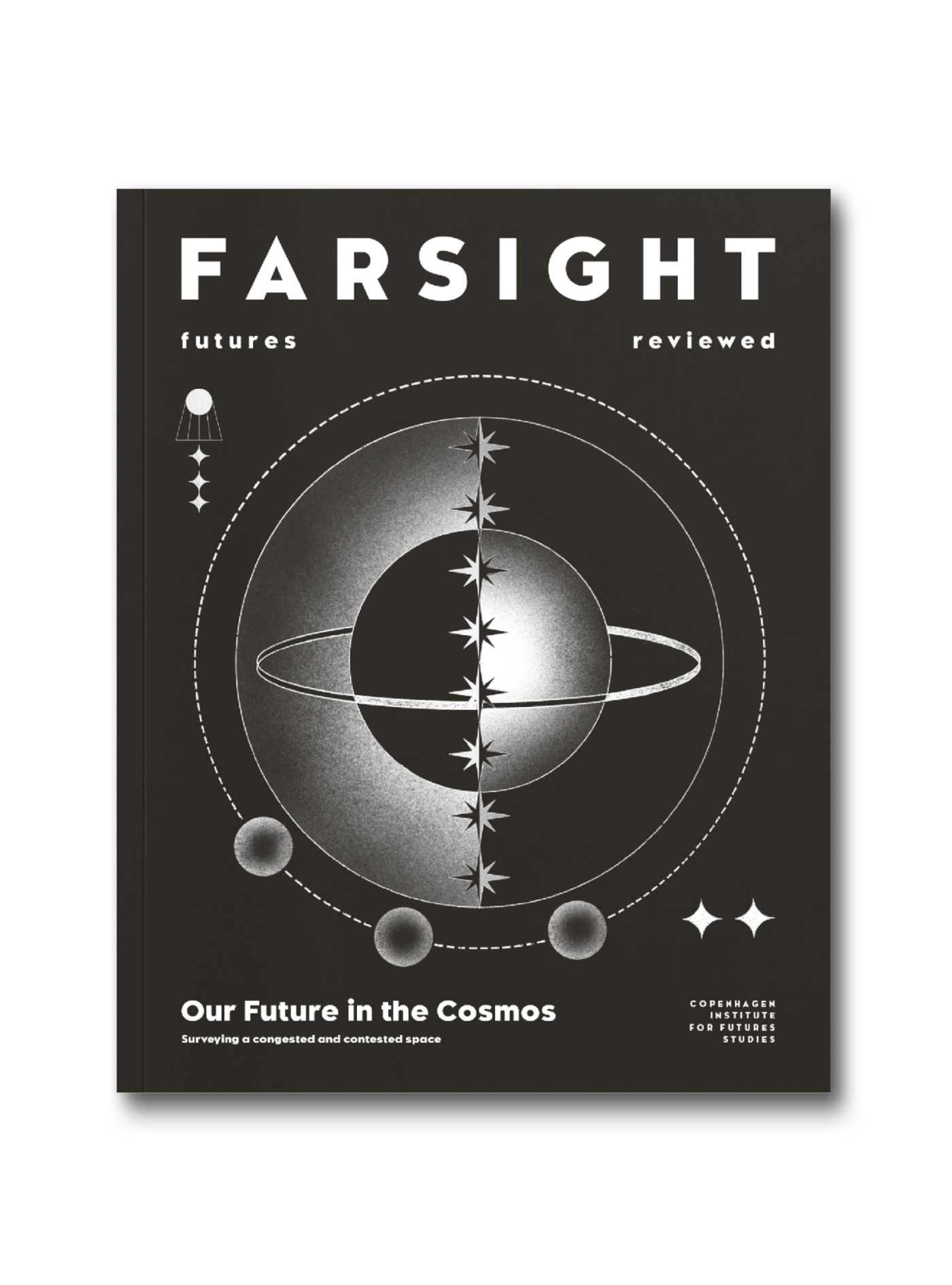
In turn, we use cookies to measure and obtain statistical data about the navigation of the users. You can configure and accept the use of the cookies, and modify your consent options, at any time.

Stardust and Dollar Signs
As the mineral-rich wealth of the cosmos is gloated at from Earth, actors are racing towards extracting, as well as regulating, its
resources.
Image: British Geological Survey
From minerals and metals to atmospheric gasses, the celestial bodies in our solar system hold a vast wealth of resources useful for a variety of space and terrestrial applications. Space mining may not yet have become a reality, and won’t be for a while, but there is a growing sense of a fortune to be made beyond Earth, and private companies and national space agencies alike are gearing up for a future where resource extraction in the cosmos becomes a technically and commercially viable endeavour.
Although space is in many ways already a heavily commercialised place – teeming with satellites enabling telecommunications, meteorological observations, precision navigation, farming data, and other vital services – resource extraction still has not been part of the equation.

Broaden your horizons with a Futures Membership. Stay updated on key trends and developments through receiving quarterly issues of FARSIGHT, live Futures Seminars with futurists, training, and discounts on our courses.
become a futures memberThat may soon change. The Artemis mission, an American-led effort to return to the Moon by 2025, comes with added ambitions of mining it for valuables. The Artemis Accords, which have so far been committed to by 32 nations, asks that partners agree to collaborate around extracting and utilising resources in a way that does not “inherently constitute national appropriation” under US-drafted rules.
China likewise has high ambitions for resource extraction beyond Earth. Shortly after the Chang’e-5 mission’s discovery of a new mineral on the Moon, Beijing made their plans for three additional probe missions public. The mineral, Changesite-( Y), contains helium-3, an isotope with low abundance on Earth which is thought be useful in fusion power technology and which could thus be a both valuable and scarce future source of energy. Like the US-led Artemis mission, China aims to eventually establish a permanent settlement on the moon, with resource extraction sure to be an integral part of their presence there.
Look beyond the Moon, and there are many mineral-rich asteroids floating around in our solar system that likewise make tempting targets for future resource grabs. Wars have been fought in the past over the rights and access to the resources on Earth, which pale in comparison to what’s stored in these extraterrestrial bodies. To take one example, the 326 km diameter asteroid ‘Davida’, located in the asteroid belt between Mars and Jupiter, contains useful resources like water, nickel, iron, nitrogen, and hydrogen. Davida has a head-spinning resource evaluation of $27 quintillion (2718 million dollars), making it the most valuable asteroid so far discovered in our solar system.
Yet Davida is far from the only tempting rock within reach. In October 2023, NASA launched the ‘Psyche’ mission with the goal of surveying an asteroid orbiting the Sun between Mars and Jupiter. Illustrating the new alliance between the national space agencies and private commercial actors in the ‘NewSpace’ sector, Psyche was the first NASA mission to have its primary payload launched aboard a SpaceX Falcon Heavy rocket. Ostensibly a scientific endeavour meant to study the formation of planets, the destination of the mission, a large metal- rich asteroid, also has vast commercial potential.
SpaceX may be the largest and most dominant private actor in the NewSpace sector, but many other start-ups and business ventures are emerging in these years. Among them are Planetary Resources Inc., backed by Google billionaires Eric Schmidt and Larry Page, with the ambition to develop a robotic space mining industry; Shackleton Energy Company, named after famous British Antarctica explorer, working towards extracting lunar water to produce rocket fuels; and TransAstra Corp., building technology which concentrates light from the sun to extract propellant biomasses from objects such as asteroids, moons, and potentially surfaces of planets.
Although the current cost of getting to and from resource-rich asteroids is so high that any return on investment would only cover a fraction of the cost, the long-term promises are alluring enough for this new batch of space-faring private ventures to pursue them. The CEO of TransAstra, Joel Sercel, has made it clear that although his company will initially focus on producing rocket propellants from asteroid water, he would eventually like to see them mine “everything on the periodic table.”

Explore the world of tomorrow with handpicked articles by signing up to our monthly newsletter.
sign up hereWhat is more unclear, however, is who gets to own what. Or, put differently, how the framework of laws and treaties that currently exist to ensure orderly conduct in space will need to be adapted to this new space economy. Although the Outer Space Treaty (a document from 1967 which forms the basis of international space law) does not prohibit resource extraction from asteroids or the Moon, it does prohibit ownership of these and other celestial bodies. The treaty states that outer space cannot be subject to national appropriation by claim of sovereignty. Should Elon Musk attempt to realise his dream to ‘occupy Mars’ (a slogan he has been seen wearing across his chest during SpaceX events and press releases) it would in fact make him a space pirate by international law. We may increasingly see the ambitions of entrepreneurs clash with the tenets of international space law in a future race to be the first to secure the riches stored on celestial bodies beyond Earth, with the legal framework struggling to catch up or secure legitimacy.
It’s not that there haven’t been attempts to settle these proprietary questions ahead of time. The Moon Treaty of 1979, developed by The Legal Subcommittee for the Committee on the Peaceful Uses of Outer Space (COPUOS), asked of its signatories to subject themselves to an international authority overseeing mining activities in space and secure equal distribution and benefit of resources between member states, with special consideration given to the interests and needs of developing countries. The treaty stipulates that celestial bodies should be dedicated solely to peaceful activities, and that their environments be preserved without disruption. Furthermore, it mandates that the United Nations be notified about the location and purpose of any station established on these bodies. Addressing a gap in the original Outer Space Treaty from 1967, the Moon Treaty of ’79 prohibits the ownership of extraterrestrial property by any non-international and non-governmental entity.
The treaty was, and is, a fiasco, many will agree, as it has so far only been signed by 18 states and ratified by five – none of which are major space powers that engage in self-launched spaceflight like China, Russia, and the US. Nations like these, predictably, might be more unwilling than lesser space powers to share what they consider “theirs” based on decades of research and investment.
Looking to the future of the space mining industry, one could imagine a dominant role for some of the largest mining corporations already existing on Earth that may be looking for ways to expand their reach. It is not unthinkable that oil and gas companies such as the Saudia Arabian Oil Co. or China Petroleum & Chemical Corp., which have the economic muscle to invest in space mining technology and launch infrastructure, could easily become space companies if they decided to.
It is also not unimaginable that current space-adjacent technology providers may soon enter the cosmic gold rush as well, supporting the exploitation of space to sustain the production of crucial technologies on Earth. Perhaps one day raw materials that are increasingly scarce on Earth will be sourced from other parts of the galaxy, and the utilisation of them in the production of energy, technology, or consumer products may even happen in space, before being transported back to our planet.
These are speculations for the far future. Among the more immediate concerns is the fact that the increased accessibility that both enables and drives the NewSpace industry may paradoxically risk making space less accessible. The already significant issue of space debris generated either through accidental collisions or by the deliberate shutdown of non-functioning satellites in Earth’s orbit can be expected to become more severe as a growing number of entrants seek their fortunes in the cosmos.
There is also the question of whether a new space narrative – one that will be increasingly driven by economic rather than scientific motivations – will gain the support of the public, especially if it is thought to be a continuation of past patterns of colonial and environmental exploitation. Companies investing in or carrying out space mining activities for the sake of profit may be tempted to engage in spacewashing, i.e., misleading or persuading of the public into believing they are nobly investing in space projects for the sake of scientific and societal good to mask their true exploitive motivation.
In other words, private commercial spacefaring actors might see a benefit in piggybacking on the narrative of scientific discovery that has fostered public support of space programmes in the past. Already today, we find these sorts of narratives in the statements of NewSpace actors portraying their agenda as one that is united with that of humanity. Moon Express, which became the first private company to receive US government approval to send a robotic spacecraft to the moon, states that their mission is to “redefine [the] possible by returning to the Moon and unlocking its mysteries and resources for the benefit of humanity.”
Similarly, TransAstra ties their commercial ambitions in space to an optimism for an “unlimited future for our children and their children,” while couching resource extraction in the language of sustainability, stating that the purpose of asteroid mining is to support “sustainable exponential human growth for a millennium without straining the Earth’s biosphere.” In other words, we must look towards the universe to save ourselves on Earth.
Of course, such bold promises are not always fulfilled. Look no further than to companies like Planetary Resources and Deep Space Industries (the latter now defunct) which were the centrepieces in a space mining hype bubble in the 2010s that hasn’t come to fruition – despite claims that we would be mining asteroids in the first half of the 2020s. As we enter this next phase of commercial spaceflight, it remains to be seen to what degree the new batch of commercial space actors will succeed. Space, after all, is a hard thing to do – much harder than the marketing would sometimes have us believe.

This is an article from FARSIGHT:
Our Future in the Cosmos
Grab a copy here